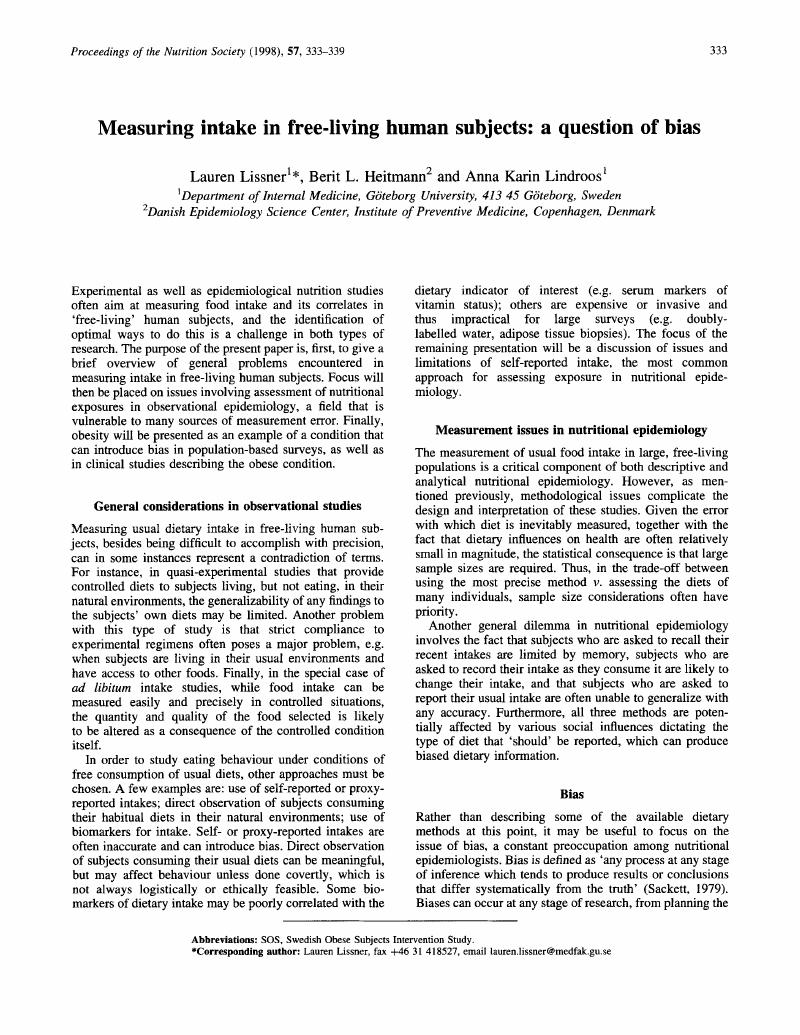Crossref Citations
This article has been cited by the following publications. This list is generated based on data provided by Crossref.
Astrup, Arne
1998.
The American paradox: the role of energy-dense fat-reduced food in the increasing prevalence of obesity.
Current Opinion in Clinical Nutrition and Metabolic Care,
Vol. 1,
Issue. 6,
p.
573.
Rolls, Barbara J
Bell, Elizabeth A
Castellanos, Victoria H
Chow, Mosuk
Pelkman, Christine L
and
Thorwart, Michelle L
1999.
Energy density but not fat content of foods affected energy intake in lean and obese women.
The American Journal of Clinical Nutrition,
Vol. 69,
Issue. 5,
p.
863.
Green, S.M.
Winterberg, H.
Franks, P.J.
Moffatt, C.J.
Eberhardie, C.
and
McLaren, S.
1999.
Nutritional intake in community patients with pressure ulcers.
Journal of Wound Care,
Vol. 8,
Issue. 7,
p.
325.
Lafay, L
Mennen, L
Basdevant, A
Charles, MA
Borys, JM
Eschwège, E
and
Romon, M
2000.
Does energy intake underreporting involve all kinds of food or only specific food items? Results from the Fleurbaix Laventie Ville Santé (FLVS) study.
International Journal of Obesity,
Vol. 24,
Issue. 11,
p.
1500.
Goris, Annelies HC
Westerterp-Plantenga, Margriet S
and
Westerterp, Klaas R
2000.
Undereating and underrecording of habitual food intake in obese men: selective underreporting of fat intake.
The American Journal of Clinical Nutrition,
Vol. 71,
Issue. 1,
p.
130.
Mennen, LI
Jackson, M
Cade, J
Mbanya, JC
Lafay, L
Sharma, S
Walker, S
Chungong, S
Wilks, R
Balkau, B
Forrester, T
and
Cruickshank, JK
2000.
Underreporting of energy intake in four populations of African origin.
International Journal of Obesity,
Vol. 24,
Issue. 7,
p.
882.
Maillard, G
Charles, MA
Lafay, L
Thibult, N
Vray, M
Borys, J-M
Basdevant, A
Eschwège, E
and
Romon, M
2000.
Macronutrient energy intake and adiposity in non obese prepubertal children aged 5–11 y (the Fleurbaix Laventie Ville Santé Study).
International Journal of Obesity,
Vol. 24,
Issue. 12,
p.
1608.
Lissner, Lauren
Heitmann, Berit L.
and
Bengtsson, Calle
2000.
Population studies of diet and obesity.
British Journal of Nutrition,
Vol. 83,
Issue. S1,
p.
S21.
Ambrosini, GL
de Klerk, NH
Musk, AW
and
Mackerras, D
2001.
Agreement between a brief food frequency questionnaire and diet records using two statistical methods.
Public Health Nutrition,
Vol. 4,
Issue. 2,
p.
255.
Goris, Annelies HC
Meijer, Erwin P
Kester, Arnold
and
Westerterp, Klaas R
2001.
Use of a triaxial accelerometer to validate reported food intakes.
The American Journal of Clinical Nutrition,
Vol. 73,
Issue. 3,
p.
549.
Lissner, Lauren
2002.
Measuring food intake in studies of obesity.
Public Health Nutrition,
Vol. 5,
Issue. 6a,
p.
889.
Kant, Ashima K.
2002.
Nature of Dietary Reporting by Adults in the Third National Health and Nutrition Examination Survey, 1988–1994.
Journal of the American College of Nutrition,
Vol. 21,
Issue. 4,
p.
315.
Kant, AK
2002.
Weight-loss attempts and reporting of foods and nutrients, and biomarkers in a national cohort.
International Journal of Obesity,
Vol. 26,
Issue. 9,
p.
1194.
Westerterp, Klaas R.
and
Goris, Annelies H.C.
2002.
Validity of the assessment of dietary intake: problems of misreporting.
Current Opinion in Clinical Nutrition and Metabolic Care,
Vol. 5,
Issue. 5,
p.
489.
Rissanen, A
Hakala, P
Lissner, L
Mattlar, C-E
Koskenvuo, M
and
Rönnemaa, T
2002.
Acquired preference especially for dietary fat and obesity: a study of weight-discordant monozygotic twin pairs.
International Journal of Obesity,
Vol. 26,
Issue. 7,
p.
973.
Ambrosini, GL
Mackerras, D
de Klerk, NH
and
Musk, AW
2003.
Comparison of an Australian food-frequency questionnaire with diet records: implications for nutrition surveillance.
Public Health Nutrition,
Vol. 6,
Issue. 4,
p.
415.
Laaksonen, David E.
Laukkanen, Jari A.
Niskanen, Leo
Nyyssönen, Kristiina
Rissanen, Tiina H.
Voutilainen, Sari
Pukkala, Eero
Hakkarainen, Anna
and
Salonen, Jukka T.
2004.
Serum linoleic and total polyunsaturated fatty acids in relation to prostate and other cancers: A population‐based cohort study.
International Journal of Cancer,
Vol. 111,
Issue. 3,
p.
444.
Moses, A W G
Slater, C
Preston, T
Barber, M D
and
Fearon, K C H
2004.
Reduced total energy expenditure and physical activity in cachectic patients with pancreatic cancer can be modulated by an energy and protein dense oral supplement enriched with n-3 fatty acids.
British Journal of Cancer,
Vol. 90,
Issue. 5,
p.
996.
Heitmann, Berit Lilienthal
and
Lissner, Lauren
2005.
Can adverse effects of dietary fat intake be overestimated as a consequence of dietary fat underreporting?.
Public Health Nutrition,
Vol. 8,
Issue. 8,
p.
1322.
Svendsen, Mette
and
Tonstad, Serena
2006.
Accuracy of food intake reporting in obese subjects with metabolic risk factors.
British Journal of Nutrition,
Vol. 95,
Issue. 3,
p.
640.





